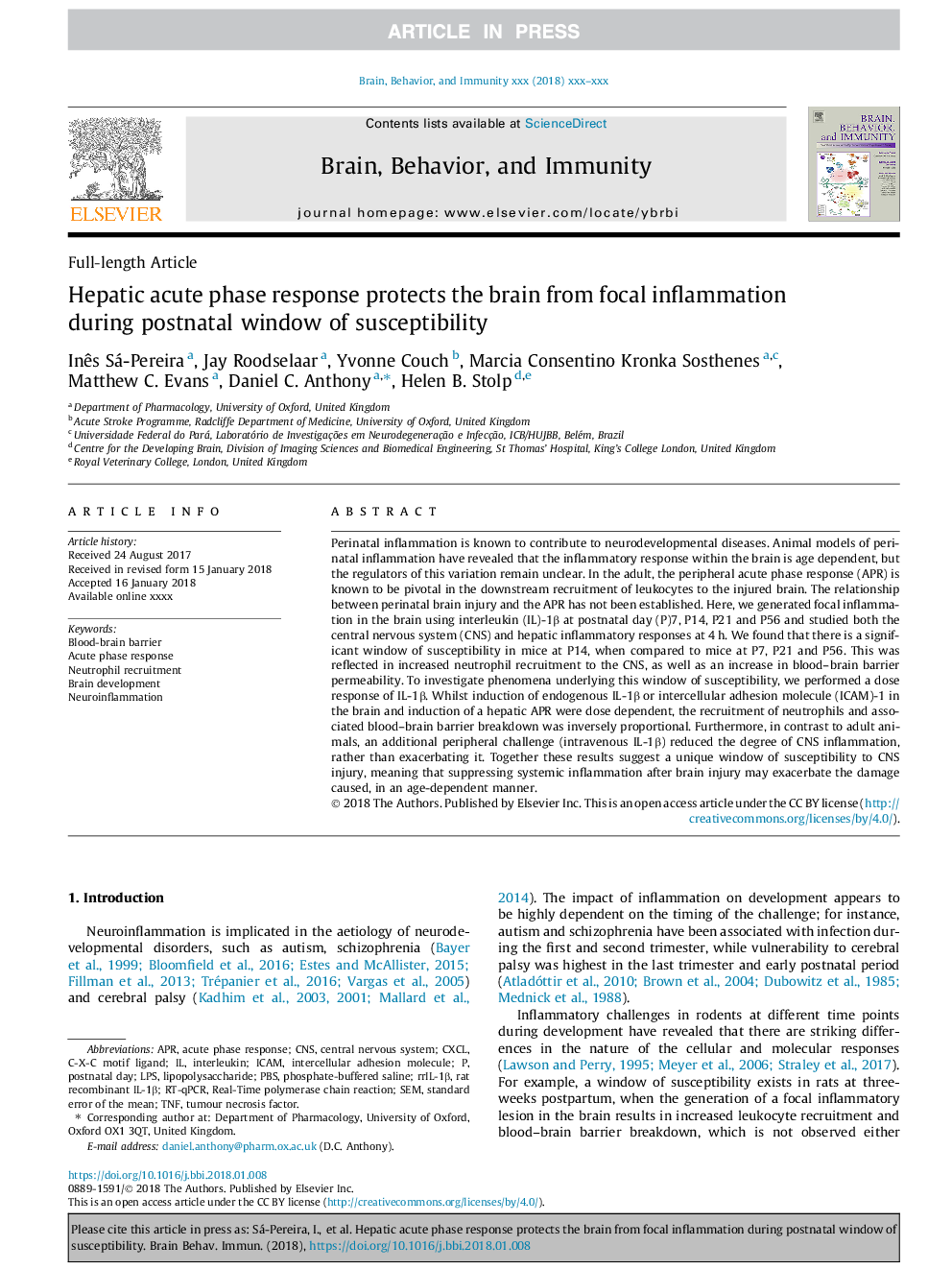| کد مقاله | کد نشریه | سال انتشار | مقاله انگلیسی | نسخه تمام متن |
|---|---|---|---|---|
| 7279535 | 1473897 | 2018 | 13 صفحه PDF | دانلود رایگان |
عنوان انگلیسی مقاله ISI
Hepatic acute phase response protects the brain from focal inflammation during postnatal window of susceptibility
ترجمه فارسی عنوان
واکنش فازی حاد کبدی مغز را از التهاب کانال در حین حساسیت پس از تولد محافظت می کند
دانلود مقاله + سفارش ترجمه
دانلود مقاله ISI انگلیسی
رایگان برای ایرانیان
کلمات کلیدی
LPSC-X-C motif ligandTNFCXCLICAMRT-qPCRPBSApr - آوریلNeutrophil recruitment - استخدام نوتروفیلNeuroinflammation - التهاب عصبیinterleukin - اینترلوکینstandard error of the mean - خطای استاندارد میانگینCNS - دستگاه عصبی مرکزیBrain development - رشد مغز postnatal day - روز پس از زایمانcentral nervous system - سیستم عصبی مرکزیtumour necrosis factor - عامل نکروز تومورlipopolysaccharide - لیپوپلی ساکاریدBlood-brain barrier - مانع خون مغزیPhosphate-buffered saline - محلول نمک فسفات با خاصیت بافریSEM - مدل معادلات ساختاری / میکروسکوپ الکترونی روبشیintercellular adhesion molecule - مولکول چسبندگی بین سلولیreal-time polymerase chain reaction - واکنش زنجیره ای پلیمراز واقعی در زمان واقعیacute phase response - پاسخ فاز حاد
موضوعات مرتبط
علوم زیستی و بیوفناوری
ایمنی شناسی و میکروب شناسی
ایمونولوژی
چکیده انگلیسی
Perinatal inflammation is known to contribute to neurodevelopmental diseases. Animal models of perinatal inflammation have revealed that the inflammatory response within the brain is age dependent, but the regulators of this variation remain unclear. In the adult, the peripheral acute phase response (APR) is known to be pivotal in the downstream recruitment of leukocytes to the injured brain. The relationship between perinatal brain injury and the APR has not been established. Here, we generated focal inflammation in the brain using interleukin (IL)-1β at postnatal day (P)7, P14, P21 and P56 and studied both the central nervous system (CNS) and hepatic inflammatory responses at 4â¯h. We found that there is a significant window of susceptibility in mice at P14, when compared to mice at P7, P21 and P56. This was reflected in increased neutrophil recruitment to the CNS, as well as an increase in blood-brain barrier permeability. To investigate phenomena underlying this window of susceptibility, we performed a dose response of IL-1β. Whilst induction of endogenous IL-1β or intercellular adhesion molecule (ICAM)-1 in the brain and induction of a hepatic APR were dose dependent, the recruitment of neutrophils and associated blood-brain barrier breakdown was inversely proportional. Furthermore, in contrast to adult animals, an additional peripheral challenge (intravenous IL-1β) reduced the degree of CNS inflammation, rather than exacerbating it. Together these results suggest a unique window of susceptibility to CNS injury, meaning that suppressing systemic inflammation after brain injury may exacerbate the damage caused, in an age-dependent manner.
ناشر
Database: Elsevier - ScienceDirect (ساینس دایرکت)
Journal: Brain, Behavior, and Immunity - Volume 69, March 2018, Pages 486-498
Journal: Brain, Behavior, and Immunity - Volume 69, March 2018, Pages 486-498
نویسندگان
Inês Sá-Pereira, Jay Roodselaar, Yvonne Couch, Marcia Consentino Kronka Sosthenes, Matthew C. Evans, Daniel C. Anthony, Helen B. Stolp,
